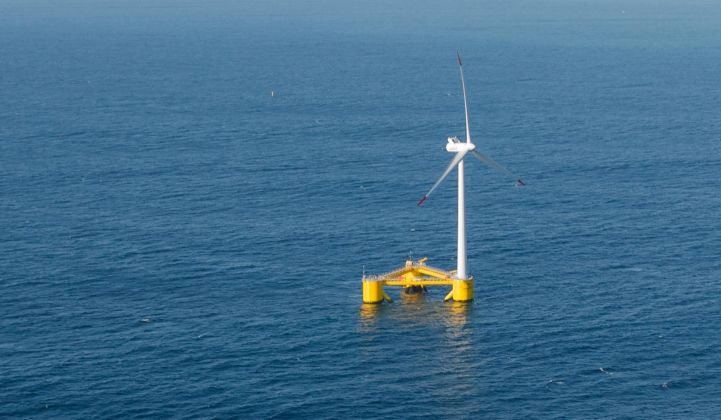Two European projects aiming to advance floating offshore wind technologies marked milestones this month.
In the first, a consortium working to commercialize floating offshore wind farms received a significant boost from a European Union innovation fund.
On October 19, the European Investment Bank (EIB) granted a 60-million-euro loan ($68 million) to WindPlus, a joint venture of EDP Renewables, Repsol and Principle Power, for the construction of a 25-megawatt floating wind farm off the northern coast of Portugal.
The funding is from the EIB’s Energy Demonstration Projects facility, which provides loans, loan guarantees, and equity financing between 7.5 million and 75 million euros ($8.5 million and $85 million) to projects that advance energy system transformation. Additional project funding comes from the EU’s NER 300 program (29.9 million euros/$34 million) and the Portuguese Carbon Fund (6 million euros/$6.8 million).
Construction on the project’s three WindFloat foundations began in early August at facilities in Portugal and Spain. WindFloat is a three-column, semi-submersible turbine foundation developed by California-based Principle Power.
The project will couple the WindFloat foundations with three 8.4-megawatt turbines supplied by MHI Vestas, a joint venture between Vestas Wind Systems A/S and Mitsubishi Heavy Industries. The Vestas 164 turbines will be the largest and most powerful turbines installed on a floating foundation to date.
According to Kevin Banister, VP and head of development at Principle Power, the project is expected to be commissioned by the third quarter of 2019.
Pushing floating offshore wind to commercialization
For the WindPlus partners, the WindFloat Atlantic project represents the next stage in their plan to enable floating offshore wind farms to compete on cost with fixed-foundation offshore wind technologies.
In Phase 1, a prototype outfitted with a WindFloat foundation and 2-megawatt turbine operated off the coast of Portugal from 2011-2016. The project’s 2-megawatt turbine was undersized for offshore applications, Banister said, but was intended to prove the viability of the technology.
“It was an entirely successful deployment. It established the technical performance of the system,” Banister told Greentech Media in an interview.
Up next is building projects that can compete in size and on cost with the largest fixed-foundation offshore wind farms.
“The next stage for us is the ability to build out larger arrays, bigger projects — 300+ megawatts — that really allow the project to take advantage of the economies of scale that drive the cost of energy down further and into that commercially competitive range,” said Banister.
He said inspiration for the WindFloat design came from the oil and gas industry, which has deployed hundreds of semi-submersible structures around the world.
“The real innovation that we’ve achieved,” Banister added, “is the marriage of the offshore wind turbine to this floating structure and understanding how the aerodynamic forces that the wind turbine experiences match up with the hydrodynamic forces that that floating foundation itself experiences.”
Innogy, Shell and Stiesdal partner on project in Norway
EU support for the WindFloat Atlantic project is a vote of confidence in a rapidly maturing technology. It also signals growing confidence that project developers will be able to access the region’s most promising wind resources.
According to an estimate cited by the WindPlus consortium, nearly 80 percent of available offshore wind resources in Europe are located in waters at least 60 meters deep, beyond the depth at which fixed-foundation turbines are economical.
Floating turbines can be deployed regardless of water depth, Banister noted, which opens new markets around the world, such as California and Japan, for offshore wind development. The WindFloat Atlantic project will be anchored to the seabed at a depth of 100 meters at a distance of 20 kilometers (12.4 miles) from the shore.
Earlier in October, another European floating offshore wind project advanced with backing from Innogy SE, Shell, and Stiesdal Offshore Technologies A/S (SOT). The three entities agreed to partner on a project to demonstrate SOT’s TetraSpar floating foundation concept off the coast of Norway.
The project partners contend the TetraSpar foundation’s modular layout, which includes a tubular steel main structure and suspended keel, will be cheaper to build than existing floating wind foundation technologies.
“The floating offshore wind market is evolving, but until now, floating foundations have been stubbornly expensive. This demonstration project will give us a better understanding of how the cost can be driven down,” said Hans Bünting, chief operating officer of renewables for Innogy SE, in a statement.
The 18-million-euro ($20.5 million) demonstration project, which will be outfitted with a 3.6-megawatt Siemens Gamesa offshore turbine, is expected to be deployed at the Marine Energy Test Centre, near Stavanger, Norway, in 2019. The project will be sited 10 kilometers (6.2 miles) from shore and anchored to the seafloor in waters 200 meters deep.
Separately, the Norwegian government is set to unveil two new sites for floating offshore wind plants later this year, a minister announced over the summer. Energy industry players are also eyeing floating wind projects in Asia.
Floating offshore wind might also be coming soon to the U.S. as well. Earlier this year, the Redwood Coast Energy Authority selected a consortium of companies to pursue the development of an offshore wind energy project off the Northern California coast.




